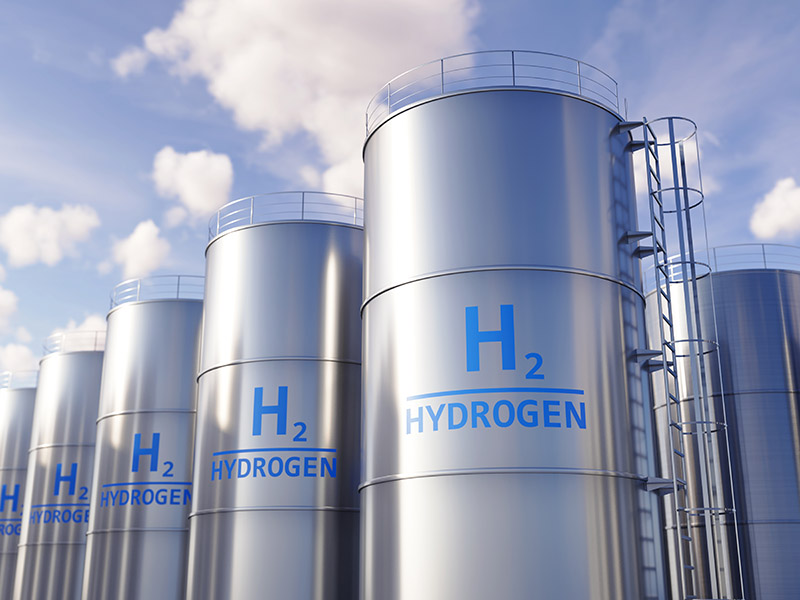
Hydrogen is regarded as a key technology for the energy transition and plays a major role in the battle against climate change when using fossil energy carriers. In the ideal case it can be generated inexpensively and in a climate-neutral manner using surplus electricity from renewable sources. As promising as its use is, its handling is challenging: hydrogen places very high demands on the material of the components – especially in the case of control and stop valves, the reliable function of which has to be ensured even under demanding operating conditions.
Sliding gate valves and seat valves from Schubert & Salzer are ideally suited for use with hydrogen. They are technically mature, reliably gas-tight and have proven themselves in hydrogen applications for many years.
Hydrogen valves made of proven materials
Hydrogen is the smallest and lightest of all atoms. Due to its small size, it can easily diffuse into many materials, where it leads to structural changes. This can cause considerable damage, which is why hydrogen places special demands on the selection of materials.
Ferritic and martensitic steels, as well as some high-alloy steels, are susceptible to hydrogen-induced cracking, also known as hydrogen embrittlement. Here, hydrogen atoms diffuse into the material and are deposited at defects or offsets. The steel loses toughness, becomes brittle and can fail under load.
Even classic sealing materials such as EPDM or fluorocarbon rubber cannot simply be used in the hydrogen environment. Hydrogen diffuses easily into the molecular chains of the elastomers. A sudden drop in pressure can lead to a sudden expansion of the volume of the stored hydrogen. The seal is destroyed because the gas cannot escape quickly enough. In such cases, the use of special elastomers or metallic seals such as copper is necessary.
For use in hydrogen applications, therefore, sliding gate valves from Schubert & Salzer are manufactured from austenitic steels such as 1.4408 and 1.4404 (and, if required, also from Alloy C276), which have excellent resistance to hydrogen embrittlement. Seat valves are made of stainless steel 1.4408 for this area of application. For high pressures, metallic seals made of copper are used instead of elastomers.
Hydrogen valves with excellent gas tightness
Hydrogen is highly flammable and has an exceptionally wide explosion range of 4 to 75 percent by volume in air – significantly larger than propane or methane. In view of these properties, the reliable internal and external gas tightness of hydrogen valves is a central safety criterion. Especially in closed or poorly ventilated areas, even the smallest leaks can lead to the formation of flammable mixtures – with a correspondingly high risk potential.
Due to their spindle and body seal, sliding gate valves from Schubert & Salzer are technically permanently gas-tight in accordance with TRGS 500. They meet the requirements of the Technical Instructions on Air Quality Control 2021 (according to EN ISO 15848-1) and have a DVGW certificate according to DIN 16678. Special versions for hydrogen achieve body leaks of less than 5 x 10-6 mbar*l/s (helium, measured using the helium sniff test according to ISO 15848-2 at 6 bar) and are therefore suitable for use even in enclosed spaces.
Selected seat valves are suitable for hydrogen applications in accordance with Category I of the PED. Equipped, for example, with metal bellows, welding ends or flange connections, angle seat valves and flange valves exhibit excellent internal and external gas tightness. In particular, it is recommended to use types 7015 and 7025 with certification of the leak rate according to the Technical Instructions on Air Quality Control in accordance with EN ISO 15848-1.
For both sliding gate valves and seat valves, a helium leak test can be performed to test the external gas tightness (helium, measured using the helium sniff test according to ISO 15848-2 at 6 bar).
Application examples for stop and control valves in the field of hydrogen:
- Electrolysis
- Steam reforming
- Test benches for fuel cells
- Test benches for aircraft engines
- Burner application in the steel, glass and building materials industry
- Atmosphere furnaces for the carburisation, bright annealing, tempering and hardening of metals
- Gas mixers for welding applications
- Manufacture of trichlorosilane
- Polysilicon filter cleaning
- Chlorine alkali electrolysis for the production of chlorine in chemistry

